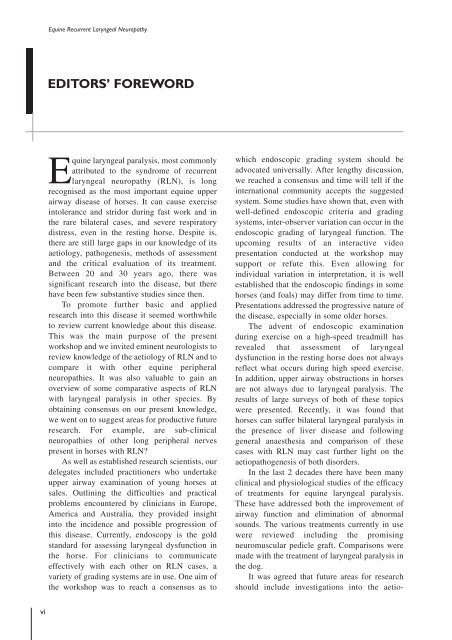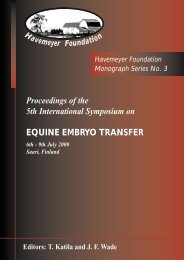Proceedings of a Workshop on - The Havemeyer Foundation
Proceedings of a Workshop on - The Havemeyer Foundation
Proceedings of a Workshop on - The Havemeyer Foundation
You also want an ePaper? Increase the reach of your titles
YUMPU automatically turns print PDFs into web optimized ePapers that Google loves.
Equine Recurrent Laryngeal Neuropathy<br />
EDITORS’ FOREWORD<br />
Equine laryngeal paralysis, most comm<strong>on</strong>ly<br />
attributed to the syndrome <str<strong>on</strong>g>of</str<strong>on</strong>g> recurrent<br />
laryngeal neuropathy (RLN), is l<strong>on</strong>g<br />
recognised as the most important equine upper<br />
airway disease <str<strong>on</strong>g>of</str<strong>on</strong>g> horses. It can cause exercise<br />
intolerance and stridor during fast work and in<br />
the rare bilateral cases, and severe respiratory<br />
distress, even in the resting horse. Despite is,<br />
there are still large gaps in our knowledge <str<strong>on</strong>g>of</str<strong>on</strong>g> its<br />
aetiology, pathogenesis, methods <str<strong>on</strong>g>of</str<strong>on</strong>g> assessment<br />
and the critical evaluati<strong>on</strong> <str<strong>on</strong>g>of</str<strong>on</strong>g> its treatment.<br />
Between 20 and 30 years ago, there was<br />
significant research into the disease, but there<br />
have been few substantive studies since then.<br />
To promote further basic and applied<br />
research into this disease it seemed worthwhile<br />
to review current knowledge about this disease.<br />
This was the main purpose <str<strong>on</strong>g>of</str<strong>on</strong>g> the present<br />
workshop and we invited eminent neurologists to<br />
review knowledge <str<strong>on</strong>g>of</str<strong>on</strong>g> the aetiology <str<strong>on</strong>g>of</str<strong>on</strong>g> RLN and to<br />
compare it with other equine peripheral<br />
neuropathies. It was also valuable to gain an<br />
overview <str<strong>on</strong>g>of</str<strong>on</strong>g> some comparative aspects <str<strong>on</strong>g>of</str<strong>on</strong>g> RLN<br />
with laryngeal paralysis in other species. By<br />
obtaining c<strong>on</strong>sensus <strong>on</strong> our present knowledge,<br />
we went <strong>on</strong> to suggest areas for productive future<br />
research. For example, are sub-clinical<br />
neuropathies <str<strong>on</strong>g>of</str<strong>on</strong>g> other l<strong>on</strong>g peripheral nerves<br />
present in horses with RLN?<br />
As well as established research scientists, our<br />
delegates included practiti<strong>on</strong>ers who undertake<br />
upper airway examinati<strong>on</strong> <str<strong>on</strong>g>of</str<strong>on</strong>g> young horses at<br />
sales. Outlining the difficulties and practical<br />
problems encountered by clinicians in Europe,<br />
America and Australia, they provided insight<br />
into the incidence and possible progressi<strong>on</strong> <str<strong>on</strong>g>of</str<strong>on</strong>g><br />
this disease. Currently, endoscopy is the gold<br />
standard for assessing laryngeal dysfuncti<strong>on</strong> in<br />
the horse. For clinicians to communicate<br />
effectively with each other <strong>on</strong> RLN cases, a<br />
variety <str<strong>on</strong>g>of</str<strong>on</strong>g> grading systems are in use. One aim <str<strong>on</strong>g>of</str<strong>on</strong>g><br />
the workshop was to reach a c<strong>on</strong>sensus as to<br />
which endoscopic grading system should be<br />
advocated universally. After lengthy discussi<strong>on</strong>,<br />
we reached a c<strong>on</strong>sensus and time will tell if the<br />
internati<strong>on</strong>al community accepts the suggested<br />
system. Some studies have shown that, even with<br />
well-defined endoscopic criteria and grading<br />
systems, inter-observer variati<strong>on</strong> can occur in the<br />
endoscopic grading <str<strong>on</strong>g>of</str<strong>on</strong>g> laryngeal functi<strong>on</strong>. <strong>The</strong><br />
upcoming results <str<strong>on</strong>g>of</str<strong>on</strong>g> an interactive video<br />
presentati<strong>on</strong> c<strong>on</strong>ducted at the workshop may<br />
support or refute this. Even allowing for<br />
individual variati<strong>on</strong> in interpretati<strong>on</strong>, it is well<br />
established that the endoscopic findings in some<br />
horses (and foals) may differ from time to time.<br />
Presentati<strong>on</strong>s addressed the progressive nature <str<strong>on</strong>g>of</str<strong>on</strong>g><br />
the disease, especially in some older horses.<br />
<strong>The</strong> advent <str<strong>on</strong>g>of</str<strong>on</strong>g> endoscopic examinati<strong>on</strong><br />
during exercise <strong>on</strong> a high-speed treadmill has<br />
revealed that assessment <str<strong>on</strong>g>of</str<strong>on</strong>g> laryngeal<br />
dysfuncti<strong>on</strong> in the resting horse does not always<br />
reflect what occurs during high speed exercise.<br />
In additi<strong>on</strong>, upper airway obstructi<strong>on</strong>s in horses<br />
are not always due to laryngeal paralysis. <strong>The</strong><br />
results <str<strong>on</strong>g>of</str<strong>on</strong>g> large surveys <str<strong>on</strong>g>of</str<strong>on</strong>g> both <str<strong>on</strong>g>of</str<strong>on</strong>g> these topics<br />
were presented. Recently, it was found that<br />
horses can suffer bilateral laryngeal paralysis in<br />
the presence <str<strong>on</strong>g>of</str<strong>on</strong>g> liver disease and following<br />
general anaesthesia and comparis<strong>on</strong> <str<strong>on</strong>g>of</str<strong>on</strong>g> these<br />
cases with RLN may cast further light <strong>on</strong> the<br />
aetiopathogenesis <str<strong>on</strong>g>of</str<strong>on</strong>g> both disorders.<br />
In the last 2 decades there have been many<br />
clinical and physiological studies <str<strong>on</strong>g>of</str<strong>on</strong>g> the efficacy<br />
<str<strong>on</strong>g>of</str<strong>on</strong>g> treatments for equine laryngeal paralysis.<br />
<strong>The</strong>se have addressed both the improvement <str<strong>on</strong>g>of</str<strong>on</strong>g><br />
airway functi<strong>on</strong> and eliminati<strong>on</strong> <str<strong>on</strong>g>of</str<strong>on</strong>g> abnormal<br />
sounds. <strong>The</strong> various treatments currently in use<br />
were reviewed including the promising<br />
neuromuscular pedicle graft. Comparis<strong>on</strong>s were<br />
made with the treatment <str<strong>on</strong>g>of</str<strong>on</strong>g> laryngeal paralysis in<br />
the dog.<br />
It was agreed that future areas for research<br />
should include investigati<strong>on</strong>s into the aetiovi








